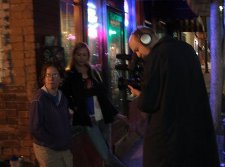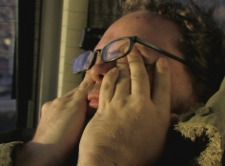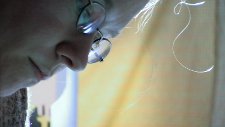
Whaley on the set of Hell Is Other People
Jarrod Whaley's debut feature Hell Is Other People tells the story of Morty - a passive-aggressive sort, living on the breadline in Chattanooga, who is well on the way to alienating himself from the few friends he has left. It might not sound like the most promising basis for a comedy, but Whaley injects this scenario with a sharp strain of uneasy humour that even came as a surprise to himself.
"It's funny," he admits, when I catch up with him as he prepares to shoot his second feature, The Glass Slipper, "when I first came at the project, I didn't conceive of it as a comedy at all. It was more of a standard dramatic thing and it really only became a comedy when Richard Johnson, who plays Morty, got involved with it. It was largely because of certain elements that he could bring to it, I thought that it would work better as a comedy with him in the role."
The film was shot in Chattanooga, Tennessee, the writer/director's home town, and it's clear that making it outside of one of the major cities presented some problems for Whaley, who has since moved to San Francisco.
"It was ridiculously hard," he says. "Chattanooga sort of styles itself as an artistic-oriented town but in fact people just love to talk about making things and it's hard to get them out of their houses to do it. For instance, just to get into the particulars of the casting, the part that eventually became Morty, who Richard plays - he was the third person I had cast in that role. The other people just dropped out, for whatever reason, at the last minute. This would happen with all the parts, I would have 80 or 90 per cent of the casting done and then someone I already had in place would drop out and I would basically have to start over. And it kept going in that fashion - a revolving door kind of pattern for a couple of years until it finally all came together.
"The only person who was on board all along was Mary Beth Sanders, who plays Emmy. She was on board from the beginning and everyone else, those parts were cast several times at least. It's so hard to get people out of their houses in Chattanooga to begin with and you're not paying people, you're asking them to give up their free time so it's a little hard to be iron fisted asking people to come to the set. It's stretched out over seven or eight months."

It sounds as though the title of Hell Is Other People was certainly true as far as shooting it was concerned.
"It sort of was a personal in - joke on that level," he says, adding that the experience of preparing to shoot his next film in San Francisco couldn't be more different.
"It's leaps and bounds easier," he says. "I put out a casting call and immediately had 30 or 40 interested people, whereas in Chattanooga it took five weeks to get 12 people to respond. I just find that people are very enthusiastic - even non - actors. They show up, they want to do this, they try very hard. It's just a world of difference. This is a big part of why I moved here. You're more capable of producing a good film when people are enthusiastic about it. The likelihood of you pulling it off is much greater."
Against the odds or not, Whaley's first feature is an accomplished debut that sees him bring his experience of working on short documentary Passion Flower into a feature environment. He says the fact that a documentarian only has one opportunity to catch something on tape helps breed discipline that he has been able to transfer to his feature work.
The 33-year-old adds: There's this strange kind of talent that you begin to develop when shooting a documentary, of editing while producing the film. You're looking for what's important and you're having to make very quick decisions about what to shoot and what to forget about, particularly if you're just shooting in a one-camera style. I think a lot of that filtered into the way that I've gone on to shoot features. The economy in the way that I'm shooting and knowing exactly what I want has directly come out of shooting documentaries. The style - the handheld, out of focus stuff - that came directly out of shooting documentary. The shorts I've made before were much more oriented around locked - down tripod, wide angle, long-take style of shooting."
And he was also keen to reclaim the hand-held loose style of shooting from the label of 'mumblecore' - the critically divisive ultra-low-budget, relationship-driven genre popularised by the likes of the Duplas Brothers and Joe Swanberg.
"There are all sorts of associations that pop up with this kind of shooting style, that mumblecore word being one of them," he says. "It's the sort of decision you can't take lightly because of that. People are going to read the film in a certain sort of way just because of the way in which it is produced. I think part of why I went with this shooting style was to try to submerse that kind of mumblecore aesthetic and bring it back to what it originally was, which is a documentary style of shooting."
And Whaley - whose film premiered earlier this year at Cinequest Film Festival in San Jose - adds that this economical way of working is quite unusual.

"I shot all this with one camera," he explains. "Basically, I do one take per set up, which is kind of a weird working, I think some filmmakers would wonder about that. Typically, if you're shooting with one camera, you would do a very stringent sort of plan as to, 'I want this angle at this moment in the scene and this angle at another moment in the scene'. You can approach it that way, or you can just shoot from every conceivable angle and try to cover yourself. And that's two different processes. And in either one of those situations, you're shooting just more material than you're ever going to use.
"What I do when I'm shooting is try to keep the amount of footage that I'm shooting down to a minimum, partially because I know what I need, but also it's such a headache in editing to go in there and have an hour of footage that needs to be cut down to one minute or something. So, basically, for every camera angle, I'll do a take from that angle and then I move on and the next take will be from a different angle entirely. I'll do four or five, tops, per scene. And I may throw in an insert or two at the end but I tend to move through it very quickly, do four or five takes and that's it."
And although it was unusual to shoot in Chattanooga, Whaley says that the town went on to inform the film.
"On a very real level, the central character of the film is Chattanooga. It's something that might not come across on first viewing because I don't shoot a lot of establishing shots or shots of local landmarks or anything like that. It's not that kind of way of setting up the place as a character. It's more filtered through the way the characters interact with each other, that being my take on how this place is, what it does to the people who live there. I think that's something that is looking like that's going to be a feature of all my films. The one I'm working on right now is about Silicon Valley in the same sort of way in that the people interact with each other based on my reading of the place. That may be something that is central to what I'm doing in the long run."
Talking about his new film, it's clear he is chomping at the bit to get going, having just reached his goal on the Kickstarter website, which aims to give people a platform to raise funds for creative projects. He plans to use the test scene - which you can watch below- in the film and I ask him to tell us a bit more about the plot.
"It's sort of a family in peril story," he says. "There's a recently broken home. The father in the family is a classic Silicon Valley entrepreneur type who made a lot of money on some big tech project. And has always been wrapped up in himself, his career and even some unsavoury sorts of things than he has been in his family. So the family has split up. His wife is used to this affluent lifestyle. She hasn't been working for the majority of their marriage and she is thrust into a situation where she has to go and get a menial job and she's forced to hire a nanny.
"The nanny comes into this situation, she's very quiet, middle-American and very out of place in the Bay area and she gets a strange crush on the husband. It's an intricate character thing. I think it's probably impossible for me not to inject some of that awkward sense of humour that you've already seen in the other film, into it. Just based on the test scene that I've already shot. It has some of that same kind of awkward humour in it. It may be that this is a little bit more straightforward because the situation is a little less comic."
For more information about The Glass Slipper, visit the film's Facebook page or see Kickstarter below. For more information about Hell Is Other People, visit the official site. 





















